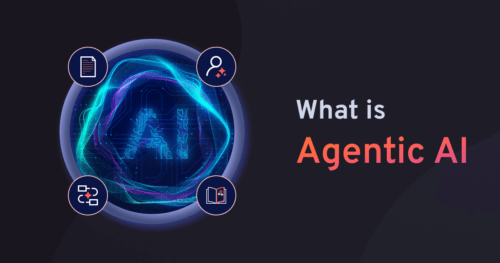What is Agentic AI?
Agentic AI is an AI system that acts autonomously, adapts in real time, and solves multi-step problems based on context and objectives. They are built of multiple AI agents that leverage large language models (LLMs) and complex reasoning. This enables them to have enhanced decision-making abilities and natural language understanding, facilitating more effective and intuitive user interactions.
Traditional artificial intelligence and then Generative AI showed great initial promise in addressing these challenges. However, they failed to deliver end-to-end enterprise solutions that could autonomously perform complex tasks and achieve business outcomes. While good at automating simple tasks, non-agentic rule-based systems are fundamentally limited by their strict adherence to rules. This means they can’t adapt, learn, and make decisions, so they can’t keep up with modern enterprises.
Agentic AI is a whole new way for AI to drive enterprise solutions. It enables systems to execute tasks independently with minimal human intervention, analyze problems, develop strategies, and act on them based on preset goals. Ultimately, it revolutionizes enterprise operations by delivering end-to-end solutions with autonomous agents that can achieve business outcomes.
Agentic AI vs Generative AI vs Traditional AI
The wave of generative AI, exemplified by large language models and natural language processing, marked a significant leap forward, allowing machines to generate various forms of content, including code and text generation. However, these models primarily function as sophisticated tools, responding to prompts rather than proactively acting independently.
| Feature | Agentic AI | Generative AI | Traditional AI |
| Primary Function | Goal-oriented action & decision-making | Content generation (text, code, images, etc.) | Focused on automating repetitive tasks |
| Autonomy | High – Operates with minimal human oversight | Variable – May require user prompts or guidance | Low – Relies on specific algorithms and set rules |
| Learning | Reinforced Learning – Improves through experience | Data-driven learning – Learns from existing data | Relies on predefined rules and human intervention |
The landscape of artificial intelligence is changing fast, and this new technology is a game-changer in the field. This paradigm shift enables us to develop and deploy agentic systems that can learn, make decisions, and interact in complex environments.
Agentic AI can optimize complex workflows, reduce costs, and respond better to changing business needs. This adaptability drives higher employee productivity, improves customer interactions, and allows businesses to stay relevant in a rapidly changing market.
The agentic system is characterized by:
- Autonomy: The ability to initiate and complete tasks without continual oversight. Agentic AI operates with limited direct human supervision, allowing for greater flexibility and efficiency in executing tasks.
- Reasoning: Sophisticated decision-making based on context and trade-offs.
- Reinforced Learning: From a machine learning method perspective, it dynamically evolves by interacting with its environment and receiving feedback from these interactions.
- Language Understanding: Leveraging natural language processing and natural language understanding (NLU), it can comprehend and follow complex instructions.
- Workflow Optimization: Efficient execution of multi-step processes.
In discussions about Agentic AI, you’ll often encounter the term ‘AI agents.’ While closely related, these terms have distinct meanings. Agentic AI is the overall concept of artificial intelligence systems that can act independently and achieve goals. AI-powered agents are the individual components within the system that execute tasks.
Agentic AI Architecture
Types of AI Agents
AI agents are the foundational elements of agentic AI architecture, driving the future of intelligent automation. At its heart, agentic AI is about seamlessly integrating specialized agents, each designed for a unique purpose.
Agent Assist enables agents to efficiently handle their day-to-day tasks directly with human-AI collaboration. These AI agents gather data from past tickets and help desk agents resolve issues quickly.
Some AI agents excel at aggregating and delivering information from diverse sources, making them ideal for dynamic, less-regulated environments. Others are meticulously crafted to operate within strict compliance frameworks, ensuring every action adheres to rigorous standards.
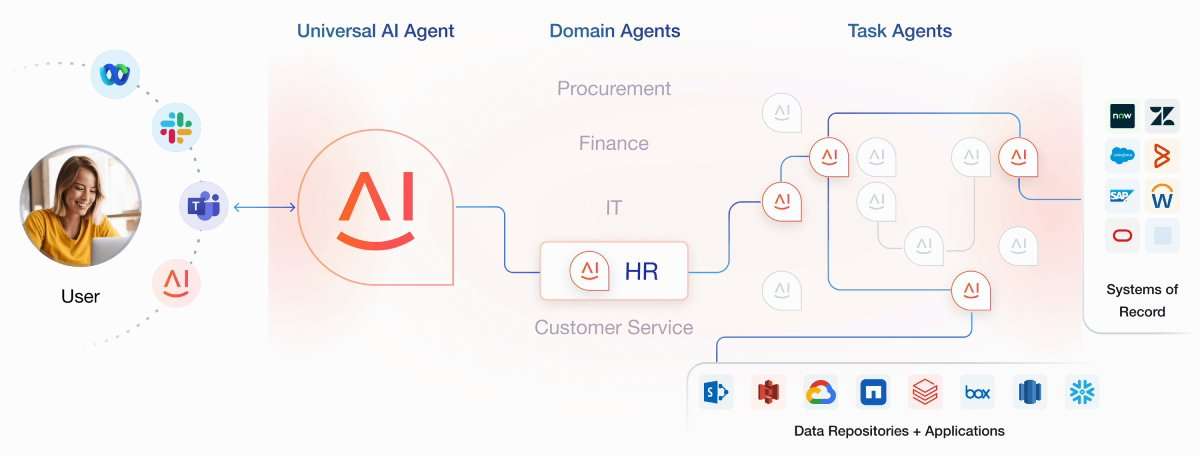
In addition, workflow-focused agents are the masterminds of automation. They intelligently generate and execute workflows across applications, autonomously identify the right APIs, determine the optimal sequence, and flawlessly fulfill user requests.
The true strength of the agentic system lies in the agentic orchestration of these diverse agents. The architecture enables them to be grouped into logical domains, simplifying deployment and management for different teams within an organization. This ensures that while each team can operate independently, they remain aligned with a cohesive AI strategy that amplifies the entire business.
Another compelling feature is the ability to integrate external agents that were not originally built on the platform. This flexibility allows companies to continuously innovate, incorporating new technologies without disrupting the existing system. It’s about fostering an ecosystem where all AI agents operate as a system of agents and work harmoniously, driving superior outcomes across the board.
These AI agents can be categorized into four types:
- Generative Information Retrieval Agents: Agents for knowledge serving less-regulated environments/topics.
- Prescriptive Knowledge Agent: Agents for knowledge serving highly regulated environments/topics.
- Dynamic Workflow Agents: Action Agents
- User Assistant Agents: User assistant agents can help individual users directly with their day-to-day tasks
Agentic AI Architecture
Agentic architecture is built on foundational principles that ensure its effectiveness and adaptability in today’s dynamic technological landscape. These principles are as follows:
- Modularity – Involves breaking down complex job functions into specialized modules, each designed for specific tasks like perception or action. This approach simplifies development and maintenance, allowing seamless upgrades without disrupting the entire system. By embracing modularity, enterprises enhance flexibility and resilience, facilitating the seamless integration of new technologies as they emerge.
- Scalability – Enables AI agents to expand their computational resources to manage increasing data and complexity. Leveraging distributed, scalable computing power and cloud infrastructures ensures that systems can grow and adapt to rising demands without sacrificing performance, keeping enterprises agile in a dynamic environment.
- Interoperability – Ensures that diverse modules and systems work together seamlessly. By utilizing standardized communication protocols and data formats, organizations can integrate various technologies and services effortlessly, maximizing operational efficiency and enhancing overall performance.
- Reinforcement learning (RL) – Allows systems to improve continuously through adaptive learning. Unlike traditional AI, RL systems evolve by interacting with their environments and learning from feedback, optimizing decision-making and responses over time. This ensures solutions remain responsive to user needs, driving greater satisfaction and engagement.
Together, these principles create a robust framework that drives key innovations, flexibility, and efficiency in solutions, positioning organizations for success in an ever-evolving landscape.
– Single-Agent System
A single-agent system features a single AI agent with various tools to address specific problems. These systems are designed for autonomous operation, utilizing both the tools’ capabilities and the reasoning power of the LLM to formulate and execute a step-by-step plan. The agent creates a strategy to achieve the user’s simple or complex goals and applies the necessary tools to complete each step. As each step progresses, the outputs are compiled to produce the final result.
The approach to achieving a user goal can vary based on the available tools, overall objectives, and constraints. Therefore, it’s crucial to design the prompt effectively, ensuring it directs the agent’s behavior and optimizes resource use to meet goals efficiently.
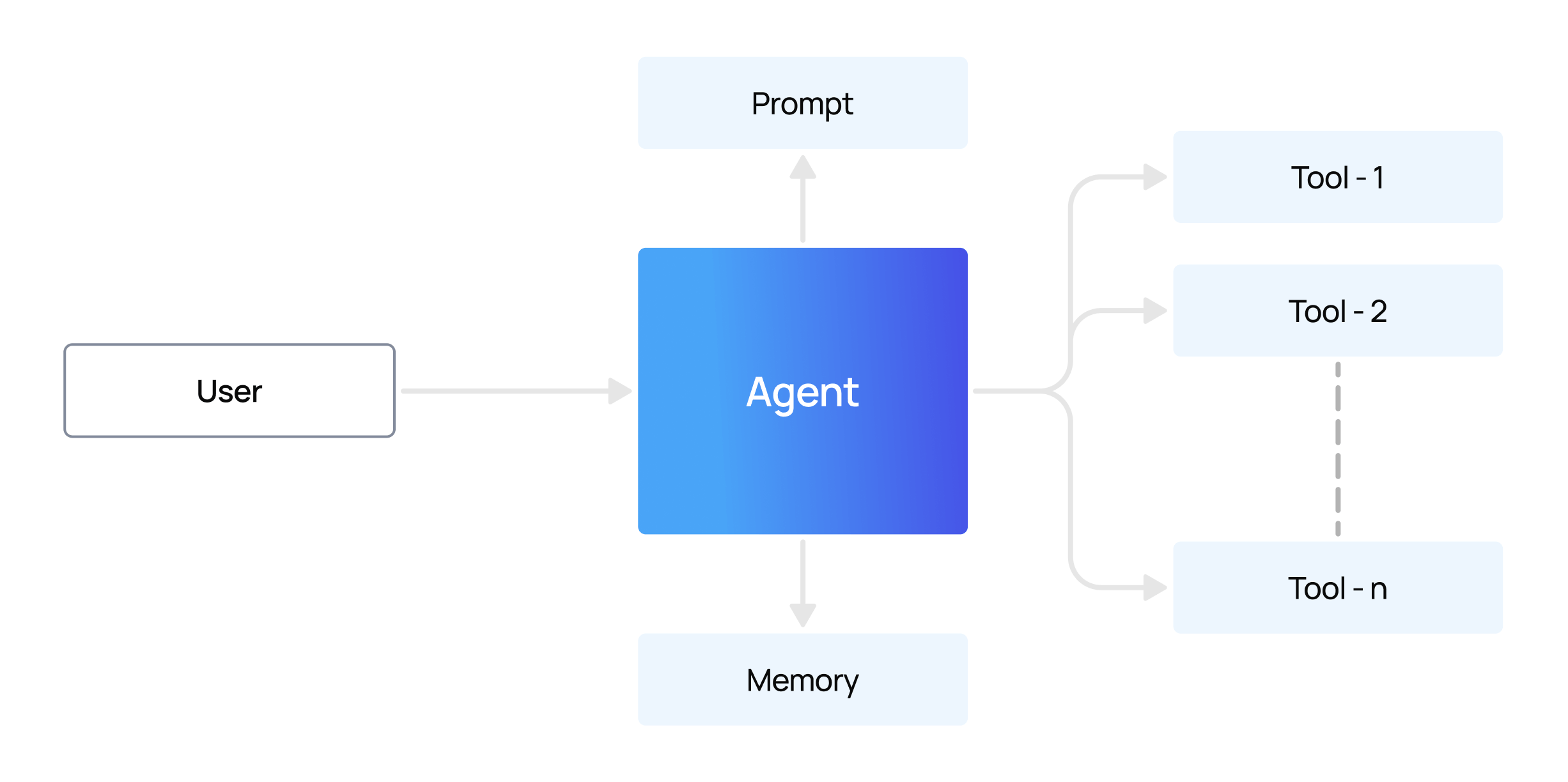
Why Single-Agent Systems Remain Relevant
Single-agent systems offer several advantages. Their simplicity makes them easier to design, implement, and manage since there’s no need to coordinate between multiple agents. This reduces the complexity of communication and interaction within the system.
These systems also provide greater coherence and consistency in decision-making. With only one agent in control, there is no risk of conflicting goals or actions, leading to more predictable and stable behavior, simplifying system understanding and debugging.
Single-agent systems are particularly effective for tasks that don’t require complex coordination. They can efficiently achieve user goals when centralized decision-making is essential.
Limitations of Single-Agent Systems
However, single-agent systems have limitations. They are often narrowly focused, which can restrict their ability to handle diverse or rapidly changing tasks. Their specialized nature may hinder performance in environments with varied requirements.
Scaling a single agent to manage broader or higher-value tasks requires significant redesign. Simply enhancing a single agent with additional capabilities may not address all scalability challenges and can lead to performance bottlenecks.
Additionally, single-agent systems face constraints related to memory and processing power. With all responsibilities concentrated in one agent, it must contend with finite resources, which can impact its overall efficiency and effectiveness.
– Multi-Agent System
In a multi-agent system (MAS) architecture, multiple independent agents—each powered by language models—collaborate to tackle complex tasks. Unlike single-agent systems, where one agent handles everything, MAS leverages each agent’s unique roles, personas, and tools to enhance efficiency and decision-making. These agents bring diverse perspectives and specialize in specific areas, which allows them to work together seamlessly and solve problems more effectively.
One key advantage of multi-agent system architecture is its scalability. As demands increase or task domains expand, additional agents can be integrated into the system without significant redesign.
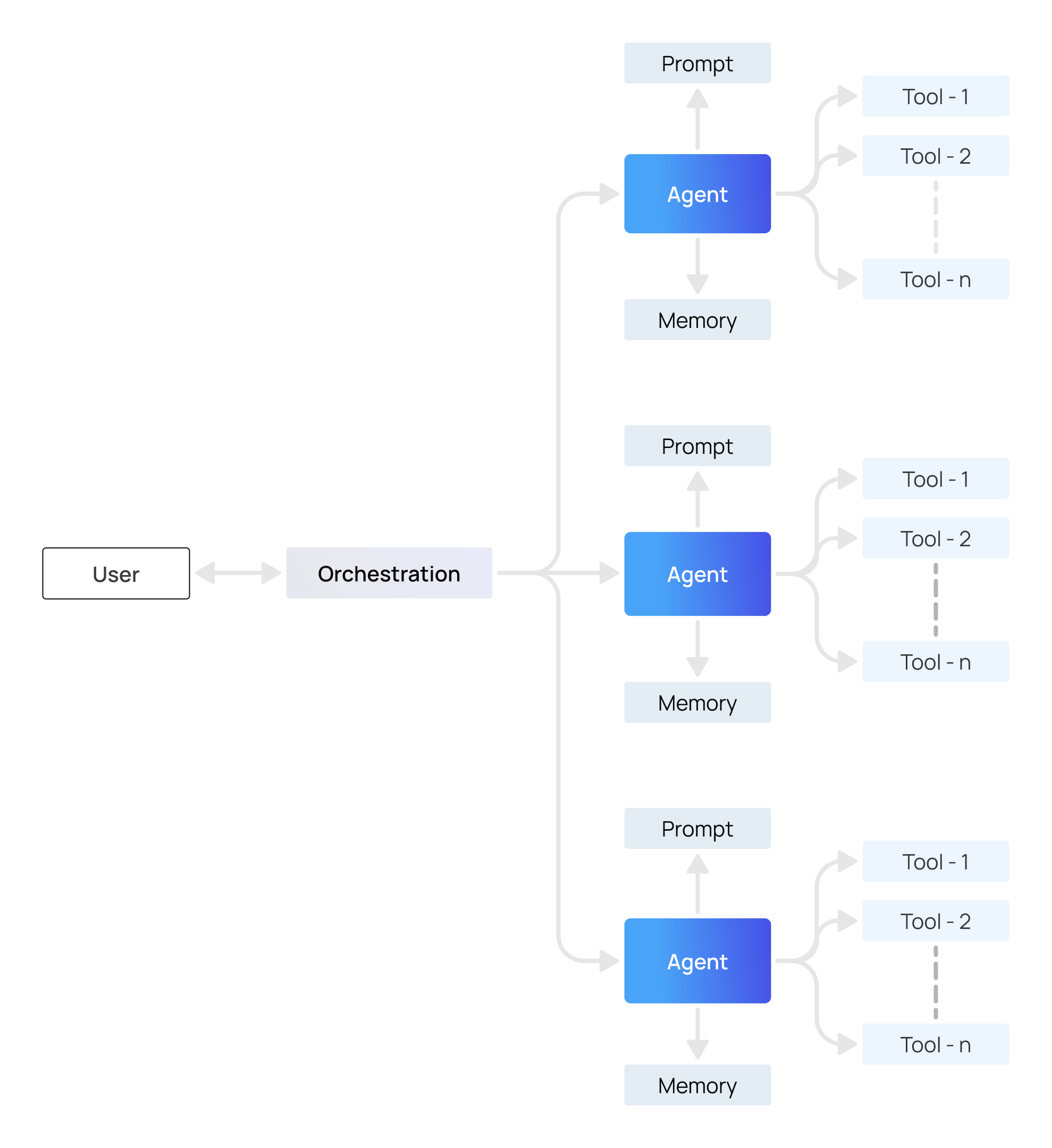
This approach ensures the system can grow and adapt to new challenges quickly. To complement this, MAS offers built-in fault tolerance; if one agent fails, others can step in, ensuring the system functions smoothly. By enabling specialization, collaboration, and resilience, multi-agent systems provide a powerful and flexible solution for handling complex, evolving tasks.
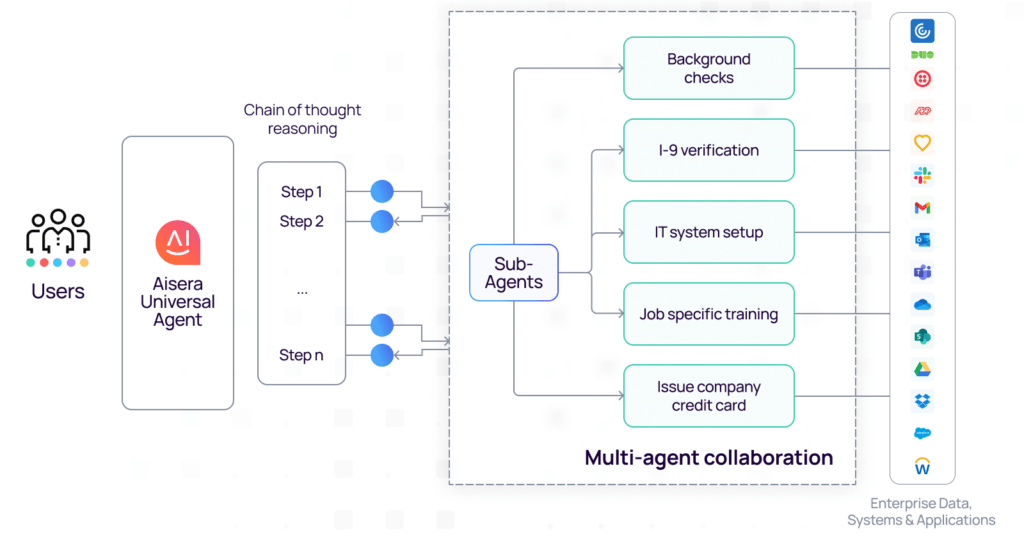
How Agentic AI Works: The Evolution and Components
At the core, they consist of sophisticated decision-making processes. These systems meticulously weigh options, anticipate outcomes, and respond effectively to unforeseen challenges. They enhance their problem-solving capabilities by consulting multiple large language models (LLMs) and cross-referencing their insights.
Moreover, agentic systems are engineered to thrive in dynamic environments, adjusting to real-time data based on feedback. This is possible through an AI innovation called reinforcement learning. The AI agents learn and automatically update their path based on these learnings. This dynamic approach ensures optimal performance across diverse and unpredictable environments.
Another key element in AI agents’ operations is machine learning. With machine learning algorithms, AI agents learn from data, recognize patterns, and make predictions. These systems learn to identify patterns, make predictions, and refine their decision-making by ingesting vast amounts of data. This continuous learning empowers them to tackle an ever-expanding range of challenges with increasing sophistication, enabling them to handle complex scenarios.
At a high level, the process unfolds in the following key stages:
- User Provides Instruction: The user interacts with the AI system, offering a natural-language prompt, similar to directing a trusted AI assistant. The system interprets the user’s intent and may seek further clarification if needed.
- Agent System Plans, Allocates, and Executes Work: The system transforms the prompt into a structured workflow, dividing it into tasks and subtasks. A managing subagent assigns these tasks to specialized subagents. These subagents, equipped with relevant domain knowledge and various tools, leverage prior experiences and established expertise to coordinate and utilize organizational data and systems to complete the assignments.
- Agent System Iteratively Refines Output: During the process, the agent may request additional input from the user to ensure the accuracy and relevance of the work. The system refines the output based on user feedback, working iteratively until the desired result is achieved.
- Agent Executes Action: Finally, the agent carries out any necessary actions to fully complete the task the user requests.
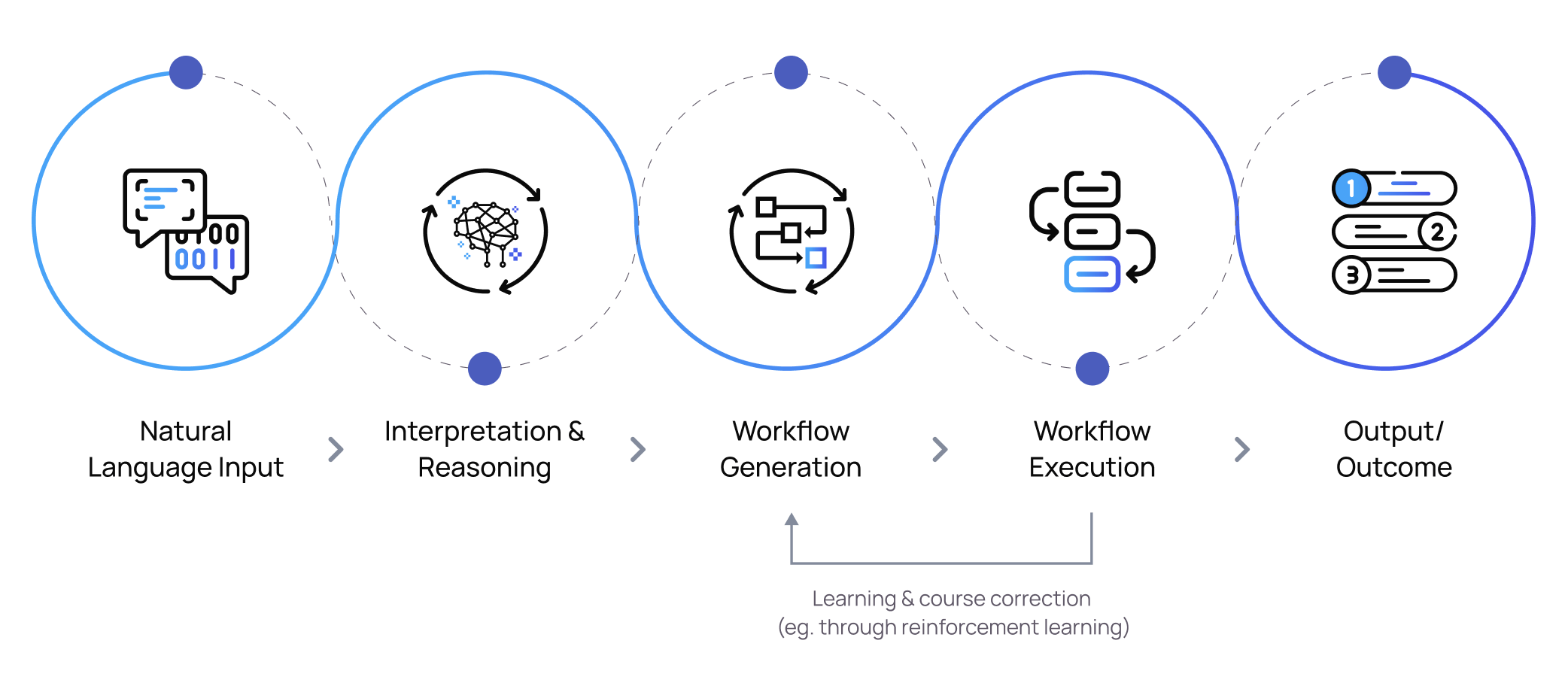
There are different types of AI-powered agents, which are the fundamental building blocks of agentic systems. Let’s take a closer look at the components of an agent. An AI agent within an agentic system consists of three main components:
- A prompt
- Memory for the Agent
- The Tools
Prompt: This defines how the system operates and outlines the specific goals an agent must achieve, along with the constraints to follow. Think of the prompt as the blueprint for the multi-agent system, setting the master plan for what each agent needs to accomplish and the methods to do so. It acts as a compass, guiding the agents and ensuring they work towards shared objectives within a structured framework. For complex systems, breaking responsibilities among multiple agents helps keep each prompt straightforward, thus managing complexity more effectively.
Memory: This is the core of an LLM agent, serving as its repository of knowledge and experiences. Just as humans rely on past experiences to make decisions, LLM agents use memory to understand context, learn from previous interactions, and make informed choices. Memory can involve simply passing conversation history back to the LLM or providing it with extracted semantic information from conversations.
Tools: These are the versatile instruments that enable agents to perform various tasks efficiently. Tools can include APIs, executable functions, or other services that help agents complete their objectives. Understanding these fundamental components, we can now explore how they integrate and function within a single-agent system.
We will cover different types of agents in detail in a separate document. Let’s dive deeper into the architecture of agentic systems.
In this video, Rahul Guha, Vice President of Product Management at Aisera, explains Agentic AI systems and highlights how enterprises like Adobe and Aramark are achieving up to 80% auto-resolution rates, demonstrating why AI agent systems are shaping the future of enterprise intelligence.
Agentic AI Applications: Benefits and Use Cases
Applications of this new technology have already shown their potential to revolutionize how individuals interact with technology, with devices like Rabbit R1. This consumer-facing success offers a tantalizing preview of agentic AI’s impact on the enterprise. At its most basic, it can automate routine tasks, freeing employees to focus on higher-value work. At its zenith, it could become a fully autonomous digital workforce capable of understanding and executing complex business objectives.
One critical application area for agentic AI is supply chain management. These intelligent systems can analyze data, predict demand, and streamline workflows, enhancing efficiency and adaptability in complex supply chain scenarios.
But please remember that agentic architecture is not a one-size-fits-all solution. Enterprises need to tailor the implementation, considering various factors. Successful implementation demands a strategic, organization-specific approach.
Firstly, crystallize your objectives. What do you aim to achieve with agentic AI? Is it to streamline operations, enhance decision-making, or develop innovative products? Clearly defined goals provide a roadmap for development and evaluation.
Secondly, identify the organizational touchpoints. Understand which departments, processes, and data will be impacted. A comprehensive assessment ensures that agentic AI aligns with the overall business strategy and minimizes disruptions.
Thirdly, cultivate a culture of continuous learning. Agentic AI is an evolving technology. Establish a framework for ongoing evaluation, adaptation, and improvement. This ensures the system remains aligned with business needs and delivers maximum value.
A standout feature of agentic architecture is its capability to strategically organize agents by functional domains such as IT, HR, Engineering, and more. This intelligent structuring enables enterprises to deploy highly specialized agents tailored to the unique demands of each department. By aligning agents with their specific functional areas, organizations can optimize AI workflows, boost task precision, and ensure that each agent operates within its area of expertise.
Let’s look at a real-time use case and how AI agents can streamline software development.
– Improving Code and Quality Management
High-quality code is a core software development requirement and is essential for successful engineering teams. However, managing code reviews, ensuring coding standards, and responding to incidents can be resource-intensive and prone to errors. By integrating AI agents into code and quality management, teams can automate these tasks, boosting developer productivity and enabling them to tackle more complex problems while keeping the codebase robust and reliable. Here’s how AI can enhance code and quality management:
– Code Acceleration and Standard Adherence
Text-to-code agents are powerful tools for engineering teams. They can generate code structures from simple text descriptions, allowing engineers to move quickly from concept to implementation. By automatically creating boilerplate code structures, these agents help ensure that coding standards and best practices are consistently applied.
– Automated Code Reviews and Quality Checks
Code reviews are vital for maintaining quality and catching bugs early. However, manual reviews can be time-consuming, especially with frequent code changes. Agentic AI can streamline this process by automatically analyzing code changes, flagging potential issues, and assessing code against predefined standards. This automation speeds up reviews, reduces the burden on senior engineers, boosts employee productivity, and ensures that no pull request goes unreviewed, enhancing overall code quality.
– Incident Response Automation
Swift incident response is critical to minimizing impact and preventing future issues. Agentic AI can automate the incident response process by triggering predefined protocols when an incident occurs. The AI can notify team members, initiate rollback procedures, and generate comprehensive incident reports, ensuring that all relevant details are captured and tracked. This speeds up response times and leads to better post-incident analysis.
– Continuous Integration and Testing Automation
Maintaining code quality requires that changes do not introduce new bugs. Agentic AI can optimize continuous integration (CI) and testing processes by automating test execution and code integration. The AI can trigger tests with each new code commit, analyze results, and update Jira tickets. If tests fail, it can notify engineers and suggest fixes. By focusing on critical areas of the codebase, the AI ensures testing resources are used efficiently.
– Agentic AI Use Cases in Customer Service
Agentic AI can learn from customer interactions and proactively address needs, offering significant advancements in customer service beyond traditional chatbots. Here are a few ways that we can leverage Agentic AI in customer service:
- AI agents can monitor systems, customer behavior, and transaction data to anticipate potential issues before they even arise. For example, if a shipping delay is detected, the AI can automatically notify the customer, explain the cause, and offer solutions like re-routing or a partial refund, all without human intervention. Similarly, for regular customers of a specific product that’s going out of stock, the AI can proactively suggest alternatives and notify them when their preferred item is back in stock.
- Unlike basic chatbots that follow pre-defined scripts, agentic AI can handle multi-step, complex inquiries by integrating with various internal systems and external APIs. For instance, if a customer reports an incorrect billing charge, the AI can independently verify the transaction, identify the error, correct it, issue a refund, and update the CRM system – all on its own. It can also assist human agents by providing real-time context, retrieving relevant knowledge base articles, and even drafting responses, effectively acting as an “AI assistant” for more intricate cases.
- Agentic AI continuously analyzes vast amounts of customer data, including browsing history, purchase patterns, preferences, and even real-time contextual information (like location or device). It then uses this understanding to deliver highly tailored content, product recommendations, and offers across various touchpoints (website, email, chat). For example, an e-commerce AI agent can dynamically adjust product suggestions as a shopper browses, or a streaming service AI could recommend shows based on viewing habits and send reminders for new episodes.
This approach dramatically improves customer satisfaction by preventing frustration and fostering a sense of being truly valued and understood. This, in turn, reduces inbound support volume, drives higher engagement and conversion rates, and ultimately builds stronger customer loyalty by showcasing a brand’s attentiveness and foresight.
Agentic AI for OnTrac Case Study
OnTrac, one of the largest regional parcel carriers, experienced a surge in customer queries, which increased operating costs and frustrated customers. With the help of AI agents built on specialized models, OnTrac improved its business processes and end-to-end customer interactions. This significantly reduced live agent interaction as customer service inquiries were self-serve while maximizing resource efficiency, allowing agents to focus on strategic initiatives. There are more AI agents examples if you are interested in learning more.
Agentic AI Solutions: Customizing and Integrating
Customization is key to maximizing the effectiveness of agentic AI. This involves integrating AI with external tools and business databases, incorporating knowledge resources, and aligning system responses with organizational goals. Successful implementation of agentic AI requires effective human-AI collaboration, ensuring that AI actions align with business strategies.
To harness the power of agentic AI, organizations must:
- Knowledge Foundation: Codify business expertise and processes to inform intelligent agent behavior.
- Infrastructure Optimization: Align data and systems for seamless AI integration.
- Human-AI Collaboration: Implement robust oversight mechanisms to balance autonomy and control.
While doing this, here are some critical considerations that enterprises should keep in mind while integrating and adopting Agentic AI
- Explainability: Understanding the reasoning behind an agentic AI’s decisions is often complex, making it difficult to troubleshoot issues or build trust.
- Bias: If the training data is biased, the agentic AI may perpetuate those biases, leading to discriminatory outcomes.
- Data privacy and security: AI systems often handle large amounts of sensitive data, making data privacy and security a critical concern.
- Ethical considerations: The nature of AI-powered autonomous agents raises moral questions about responsibility, accountability, and the potential for misuse.
- Integration complexity: Integrating agentic AI into existing enterprise infrastructure and workflows can be challenging and time-consuming.
- Risk management: It is crucial to identify and mitigate potential risks associated with AI systems, including system failures, data breaches, and reputational damage.
As enterprises integrate agentic AI, a strategic approach is essential for success. Enterprises should adopt a gradual deployment strategy, starting with controlled pilot projects to refine AI capabilities. They should also deploy specialized models for AI agents to ensure highly accurate responses and actions.
Continuous monitoring ensures transparency and accountability by tracking AI decisions in real time. A layered security framework is crucial for protecting systems, incorporating multiple defenses to safeguard against potential threats. Collaboration with AI and cybersecurity experts further optimizes the integration process, ensuring that best practices are followed and the system is secure and effective.
Another important aspect enterprises should consider when working with enterprise AI agents is setting clear boundaries between humans and AI agents. This is essential for maintaining control and ensuring responsible use.
While agentic AI is powerful, it relies on human expertise and validation to deliver accurate, relevant, and ethical outputs. Domain experts and technical specialists play a crucial role in guiding these systems, determining the data used in training, and overseeing what AI “sees” in both the real and virtual worlds. Continuous human involvement ensures AI remains a reliable and trustworthy tool, particularly for more autonomous Artificial Intelligence systems.
The objective is to use these advanced agents to enhance human capabilities, not replace them. As AI evolves to optimize and improve itself, we must provide it with the correct data and guidance to do so effectively.
Agentic AI Adoption Risks and Challenges
Agentic AI brings exciting possibilities – faster service, more intelligent automation, and entirely new ways of solving problems. But alongside that promise come some real challenges businesses can’t afford to ignore.
One of the biggest concerns is control. These AI agents are built to make decisions and take action on their own, quickly and at scale. But what happens if their goals shift or they start behaving in ways that don’t align with the business? It’s like having a brilliant team member who suddenly starts doing their own thing, and no one knows precisely why. This “black box” problem, where we can’t fully see how the AI is making decisions, makes it challenging to step in when something goes wrong.
Security and privacy are also front and center. Because these systems often need access to sensitive data and internal tools to do their jobs well, they can open the door to new risks. Hackers might try to exploit them. Subtle attacks could trick the AI into making bad decisions. And if something slips through, companies could find themselves in trouble with regulators or lose the trust of their customers.
Then there’s fairness. If these AIs are trained on biased data, they can end up making decisions that treat people unfairly, like who gets hired or who gets approved for a loan. Because they work fast and on a massive scale, minor problems can become big ones very quickly.
There’s also the human side. As AI agents get better at handling complex tasks, there’s understandable concern about what this means for jobs. Businesses have a responsibility to think ahead, to support employees, help them reskill, and find new ways for people and AI to work together.
And finally, just getting these systems up and running isn’t always easy. Integrating Agentic AI into older systems can be tricky, and keeping it all running smoothly, without bugs or strange behavior, takes time, effort, and expertise.
Agentic AI in 2025: Future Trends
Enterprises rely heavily on considerable datasets to implement agentic AI successfully. The quality and diversity of training these datasets are critical to the success of AI agents. High-quality data ensures accurate learning and better decision-making capabilities, while diverse data helps AI agents generalize across different scenarios. AI agents risk being biased or performing poorly in unexpected situations without diverse data.
Companies often struggle to implement AI due to data-related challenges. These challenges can be attributed to data regulations, sensitivity, financial implications, and scarcity.
This is where synthetic data comes into play. Synthetic data is a tool that can be utilized to create complex and varied datasets that are like real-world data but without any personal information, which reduces the risk of violating compliance regulations. Moreover, synthetic data can be produced whenever required, addressing the problem of data scarcity and enabling more effective AI model training.
In 2025 and beyond, enterprises are looking to bring domain-specific Intelligence to ensure AI agents deeply understand industry nuances and deliver precise responses and actions. Multi-agent orchestration takes this further by enabling AI agents to collaborate, automate complex workflows, and streamline operations across departments, enhancing efficiency, accuracy, and business outcomes.
Combining Synthetic and Real-world Data
The quality and breadth of data an agentic AI system receives are crucial for navigating complex business environments. For AI agents to operate independently, they must possess foundational AI reasoning skills and domain-specific knowledge, including autonomous goal-setting, planning, and adaptability, tailored to specific industries or functions.
Companies increasingly use synthetic and real-world data to train their AI to achieve this. While real-world data offers genuine insights, it often comes with limitations like scarcity, privacy concerns, and inherent biases. On the other hand, synthetic data allows for a controlled environment where diverse scenarios and edge cases can be generated, though it may not always perfectly replicate real-world complexities.
The synthetic and real-world data blend offers a compelling solution for training AI models. By integrating synthetic data, AI models can gain from increased diversity, more extensive data volumes, and reduced biases. Synthetic data can fill gaps in real-world datasets, simulate rare events, and ensure balanced representations, ultimately enhancing model robustness.
Looking ahead, there is a strong expectation that agentic AI will increasingly rely on synthetic and real-world data to train complex models. However, it’s crucial to ensure the quality of this data and maintain consistency and compatibility between the two data types. Generative models used to create synthetic data can degrade over time, so continuous monitoring and refinement are necessary to sustain performance and accuracy.
Conclusion
Agentic AI is poised to revolutionize how businesses operate. By empowering AI with independence and problem-solving abilities, we’re ushering in an era where AI and humans collaborate seamlessly. These agentic systems can tackle complex challenges, make data-driven decisions, and continuously learn to improve performance. However, realizing this potential requires a delicate balance. Transparency, ethics, and human oversight are paramount. By responsibly integrating agentic workflows, organizations can unlock unprecedented productivity and innovation.
Aisera is leading the enterprise Generative AI revolution with a comprehensive, enterprise-grade platform built on the core principles of modularity, scalability, interoperability, and reinforced learning. Our solution offers a full spectrum of agentic AI capabilities, including intelligent information retrieval, prescriptive guidance, dynamic workflow automation, and intuitive user assistance.
By seamlessly integrating with existing enterprise systems, Aisera provides a smooth path to unlocking new possibilities and the full potential of enterprise GenAI. Book a custom AI demo to experience the future of GenAI with Aisera today!

